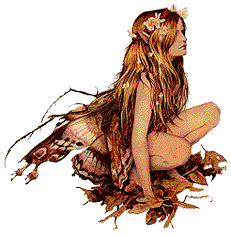Beltane and Midsummer are two particularly good times to contact the Faery world. The Faery spirit is the great force of energy moving through all things, empowering our magick.
The fae are shy creatures, made so by years of mistreatment and misunderstanding by humans. They are jealous of the physical world which contain the living, breathing, trees and plant life they so love and have so carefully reproduced in their own world. Our callous treatment of nature infuriates them.
You must work first to win their trust. Plant a faery garden as a refuge for the little folk. Leave a corner of it wild and uncultivated. Leaving out gifts of food and treasures for them is a good first step. They love ground ginger, barley, sweets, cream, and anything that glitters. Also clean water, butter, wine, honey, and bread. Never toss out faery libations like you would food for wild animals. They consider this very disrespectful. Make up a little basket of your offerings and leave them on your step, in your garden, or under a tree.
Favorite faery stones are tiger's eye, peridot, jade, lava, fluorite, and especially emerald. Don't expect these gifts to disappear, as faeries are able to extract the spiritual essence of our physical gifts to them (so be sure to leave them in love and with deep respect.) You will, however, have to replace these gifts often in order to keep the faery folk hanging around.
Whatever you do to bring life to your garden will bring faeries as well. First of all, plant plants that attract bees, butterflies, and hummingbirds. This will also attract the fae. So put up hummingbird feeders, bird feeders, bird baths, bird houses, even bat houses. Small fountains, ponds, faery statues, or waterfalls are all good.
Here's a short list of plants that attract faeries to your garden:
Common yarrow, Achillea millefolium
New York aster, Aster novi-belgii
Shasta daisy, Chrysanthemum maximum
Western giant hyssop or horsemint, Agastache occidentalis
French lavender, Lavendula dentata
Rosemary, Rosemarinus officinalis
Thyme, Thymus
Fountain butterfly bush, Buddleia alternifolia
Orange-eye butterfly bush, summer lilac, Buddleia davidii
Shrubby cinquefoil, Potentilla fruitiosa
Common garden petunia, Petunia hybrida
Verbenas, vervains, Verbena
Pincushion flowers, Scabiosa caucasica
Cosmos, Cosmos bipinnatus
Common zinnia, Zinnia elegans
They also love the following plants and trees:
foxglove, primrose, ragwort, cowslips, pansies, bluebells, clover (3-leaf, not 4-leaf), St. John's wort, hazel, rowan, blackthorn, oak, willow, elder, birch, alder, apple, ash, and especially toadstools.
Dedicating the Faery Garden
Once the garden is started, you might want to ritually dedicate it as a Faery garden sanctuary. Begin by walking the around the garden with an athame pointed at its boundaries (much like casting a circle). Then sprinkle the perimeter of the garden with a branch of fir dipped in salted spring water. Finally, walk the boundaries of the garden with a lighted incense stick. (It can be left to burn in the ground when you finish.) Then with a wand of hazel, slowly walk around the garden greeting each plant with words like:
Spirits of the (insert plant name),
I welcome your presence in the garden.
Feel your love flow from your heart, down your wand, and out the end of the wand. Be sure to welcome all plants, stones, and trees. (Nature spirits are easily offended.) Conclude your ritual with these words:
In the name of the Goddess and the God,
I declare this garden a sanctuary
For the spirits of nature
And the children of the Gods.
When you are finished, leave a gift -- cookies, soda, ale, cream, or bright, shiny things like rings, beads, or stones.
from Ancient Ways by Campanelli































0 comments:
Post a Comment